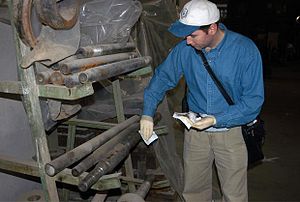
The United Nations Monitoring, Verification and Inspection Commission (UNMOVIC) and the U.S.-led Iraq Survey Group (ISG) failed to find any of the alleged stockpiles of weapons of mass destruction in Iraq that were used as an impetus for the 2003 invasion.[1] The United States effectively terminated the search effort for unconventional weaponry in 2005, and the Iraq Intelligence Commission concluded that the judgements of the U.S. intelligence community about the continued existence of weapons of mass destruction and an associated military program were wrong. The official findings by the CIA in 2004 were that Iraqi leader Saddam Hussein "did not possess stockpiles of illicit weapons at the time of the U.S. invasion in March 2003 and had not begun any program to produce them."[2]
Immediately following and during these searches, many theories were put forward on how it could be possible for these WMDs to have suddenly disappeared (assuming they were, in fact, there at first). These theories included conspiracy theories, accusations against other governments and claims of successful deception efforts by Saddam Hussein.
After much criticism against the war over the years that followed, every figure that previously supported the claims of WMDs in Iraq, with the exception of U.S. vice president Dick Cheney, acknowledged that they had been wrong.[3] A related debate concerned whether the figures that had built the case for the war had been inadvertently misled by intelligence or that they intentionally deceived the public.[4][5]
- ^ No WMD stockpiles in Iraq Archived December 17, 2007, at the Wayback Machine CNN. October 7, 2004.
- ^ Report: No WMD stockpiles in Iraq Archived November 7, 2017, at the Wayback Machine, CNN
- ^
At Least Trump Got One Thing Right. There Were No WMDs in Iraq Archived October 5, 2017, at the Wayback Machine, Huffington Post, "But the very leaders who sold them the goods on Iraq’s non-existent weapons program have (with the exception of Cheney) come out and acknowledged that there were no WMDs."
- "In his memoir, Known and Unknown, Rumsfeld specifically mentioned the lack of WMD stockpiles in Iraq and said “Saddam Hussein didn’t have ready stockpiles of WMD our intelligence community believed we would uncover. The shift in emphasis suggested that Iraq’s intentions and capability for building WMD had somehow not been threatening. Many Americans and others around the world accordingly came to believe the war was unnecessary.”
- "National Security Advisor Condoleezza Rice similarly acknowledged, “What we have is evidence that there are differences between what we knew going in and what we found on the ground.”"
- "Secretary of State Colin Powell would also state, “Of course I regret that a lot of it [the evidence] turned out be wrong.”"
- ^ Mathur, Piyush (2006). "More Whitewash: The WMD Mirage". Third World Quarterly. 27 (8): 1495–1507. doi:10.1080/01436590601027347. JSTOR 4017692. S2CID 153614528.
- ^ Dick Cheney's Biggest Lie Archived November 2, 2017, at the Wayback Machine, Newsweek